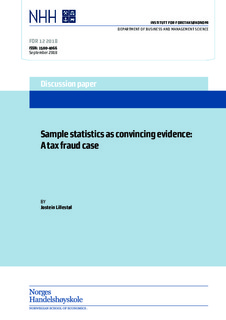| dc.description.abstract | This report deals with the analysis of data used by tax officers to support their claim of tax fraud at a pizzeria. The possibilities of embezzlement under study are overreporting of take-away sales and underreporting of cash payments. Several modelling approaches are explored, ranging from simple well-known methods to presumably more precise tools. More specifically, we contrast common methods based on normal assumptions and models based on Gamma-assumptions. For the latter, both maximum likelihood and Bayesian approaches are covered. Several criteria for the choice of method in practice are discussed, among them, how easy the method is to understand, justify and communicate to the parties. Some dilemmas present itself: the choice of statistical method, its role in building the evidence, the choice of risk factor, the application of legal principles like “clear and convincing evidence” and “beyond reasonable doubt”. The insights gained may be useful for both tax officers and defenders of the taxpayer, as well as for expert witnesses. | nb_NO |
